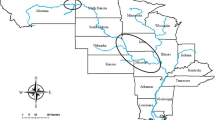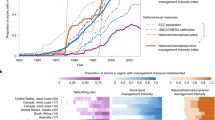Abstract
Fisheries management typically considers short planning horizons that stand in contrast to long-term sustainability and biodiversity targets, especially when evolutionary timescales play a role. Many fish stocks globally have been exploited above sustainable levels, causing fisheries-induced evolution towards smaller maturation sizes, lower growth rates and lower economic value of individual fish. Here we couple economic decision-making with eco-evolutionary fish population dynamics to explore (1) the impact of alternative planning horizons in profit-maximizing fisheries management on evolution and (2) the trade-off between profit and a set conservation target. We find that evolutionary decline is reversed only under century-long planning horizons. With more typical short-term planning, stock recovery in terms of biomass is achieved, but evolutionary decline continues, albeit at much lower rates. Setting conservation targets for genetic traits only slightly reduces profits, and the trade-off is further alleviated if the fishery can select for genotypes and thereby assist evolutionary reversal. Sustainability goals and biodiversity targets call for restoring not only fish stocks but also their genetic diversity, implying the reversal of fisheries-induced evolution. We show that economic incentives alone may not be sufficient to achieve these sustainability goals.
This is a preview of subscription content, access via your institution
Access options
Access Nature and 54 other Nature Portfolio journals
Get Nature+, our best-value online-access subscription
$29.99 / 30 days
cancel any time
Subscribe to this journal
Receive 12 digital issues and online access to articles
$119.00 per year
only $9.92 per issue
Buy this article
- Purchase on Springer Link
- Instant access to full article PDF
Prices may be subject to local taxes which are calculated during checkout



Similar content being viewed by others
Data availability
ICES SMALK (Sex Maturity Age Length Key) data are available at https://datras.ices.dk, and the ICES North Sea cod report is available at https://doi.org/10.17895/ices.pub.6092. BLE data are available at https://www.ble.de/DE/Themen/Fischerei/Fischwirtschaft/fischwirtschaft_node.html. The STECF report is available at https://stecf.jrc.ec.europa.eu/documents/43805/2832286/STECF+21-08+-+AER+2021.pdf/e85eedd6-8bf5-4a1d-b5ae-97f0889dabb4.
Code availability
The optimization code is available at https://github.com/Hdiv30/EconEvoExpl.
References
IPBES: Summary for Policemakers. In Global Assessment Report on Biodiversity and Ecosystem Services of the Intergovernmental Science–Policy Platform on Biodiversity and Ecosystem Services (Díaz, S. et al.) (IPBES Secretariat, 2019).
Therkildsen, N. O. et al. Contrasting genomic shifts underlie parallel phenotypic evolution in response to fishing. Science 365, 487–490 (2019).
Heino, M., Díaz Pauli, B. & Dieckmann, U. Fisheries-induced evolution. Annu. Rev. Ecol. Evol. Syst. 46, 461–480 (2015).
Stige, L. C. et al. Effect of a fish stock’s demographic structure on offspring survival and sensitivity to climate. Proc. Natl. Acad. Sci. USA 114, 1347–1352 (2017).
Jørgensen, C. & Holt, R. E. Natural mortality: its ecology, how it shapes fish life histories, and why it may be increased by fishing. J. Sea Res. 75, 8–18 (2013).
Barneche, D. R., Robertson, D. R., White, C. R. & Marshall, D. J. Fish reproductive-energy output increases disproportionately with body size. Science 360, 642–645 (2018).
Hixon, M. A., Johnson, D. W. & Sogard, S. M. BOFFFFs: on the importance of conserving old-growth age structure in fishery populations. ICES J. Mar. Sci. 71, 2171–2185 (2014).
Zimmermann, F. & Heino, M. Is size-dependent pricing prevalent in fisheries? The case of Norwegian demersal and pelagic fisheries. ICES J. Mar. Sci. 70, 1389–1395 (2013).
Oke, K. et al. Recent declines in salmon body size impact ecosystems and fisheries. Nat. Commun. 11, 4155 (2020).
Shackell, N. L., Frank, K. T., Fisher, J. A. D., Petrie, B. & Leggett, W. C. Decline in top predator body size and changing climate alter trophic structure in an oceanic ecosystem. Proc. R. Soc. B 277, 1353–1360 (2010).
Palkovacs, E. P., Kinnison, M. T., Correa, C., Dalton, C. M. & Hendry, A. P. Fates beyond traits: ecological consequences of human-induced trait change. Evolut. Appl. 5, 183–191 (2012).
Audzijonyte, A., Kuparinen, A., Gorton, R. & Fulton, E. A. Ecological consequences of body size decline in harvested fish species: positive feedback loops in trophic interactions amplify human impact. Biol. Lett. 9, 20121103 (2013).
Kindsvater, H. K. & Palkovacs, E. P. Predicting eco-evolutionary impacts of fishing on body size and trophic role of Atlantic cod. Copeia 105, 475–482 (2017).
Palkovacs, E. P., Moritsch, M. M., Contolini, G. M. & Pelletier, F. Ecology of harvest-driven trait changes and implications for ecosystem management. Front. Ecol. Environ. 16, 20–28 (2018).
Wood, Z. T., Palkovacs, E. P. & Kinnison, M. T. Eco-evolutionary feedbacks from non-target species influence harvest yield and sustainability. Sci. Rep. 8, 6389 (2018).
Des Roches, S., Pendleton, L. H., Shapiro, B. & Palkovacs, E. P. Conserving intraspecific variation for nature’s contributions to people. Nat. Ecol. Evol. 5, 574–582 (2021).
Conover, D. O. & Munch, S. B. Sustaining fisheries yields over evolutionary time scales. Science 297, 94–96 (2002).
Stern, N. The Economics of Climate Change—The Stern Review (Cambridge Univ. Press, 2007).
Nordhaus, W. D. A review of the stern review on the economics of climate change. J. Econ. Lit. 45, 686–702 (2007).
Weitzman, M. L. A review of the Stern Review on the economics of climate change. J. Econ. Lit. 45, 703–724 (2007).
Drupp, M. A., Freeman, M. C., Groom, B. & Nesje, F. Discounting disentangled. Am. Econ. J.: Econ. Policy 10, 109–134 (2018).
Clark, C. W. The economics of overexploitation. Science 181, 630–634 (1973).
Clark, C. W. Profit maximization and the extinction of animal species. J. Political Econ. 81, 950–961 (1973).
Grafton, R. Q., Kompas, T. & Hilborn, R. Economics of overexploitation revisited. Science 318, 1601 (2007).
Clark, C. W., Munro, G. R. & Sumaila, U. R. Limits to the privatization of fishery resources. Land Econ. 86, 209–218 (2010).
Grafton, R. Q., Kompas, T. & Hilborn, R. W. Limits to the privatization of fishery resources: comment. Land Econ. 86, 609–613 (2010).
Clark, C. W., Munro, G. R. & Sumaila, U. R. Limits to the privatization of fishery resources: reply. Land Econ. 86, 614–618 (2010).
Allendorf, F. W. & Hard, J. J. Human-induced evolution caused by unnatural selection through harvest of wild animals. Proc. Natl. Acad. Sci. USA 106, 9987–9994 (2009).
Jørgensen, C. et al. Ecology: managing evolving fish stocks. Science 318, 1247–1248 (2007).
Laugen, A. T. et al. Evolutionary impact assessment: accounting for evolutionary consequences of fishing in an ecosystem approach to fisheries management. Fish Fish. 15, 65–96 (2014).
Mace, G. M., Norris, K. & Fitter, A. H. Biodiversity and ecosystem services: a multilayered relationship. Trends Ecol. Evol. 27, 19–26 (2012).
CBD Convention on Biological Diversity (United Nations, 1992).
Zimmermann, F. & Jørgensen, C. Bioeconomic consequences of fishing-induced evolution: a model predicts limited impact on net present value. Can. J. Fish. Aquat. Sci. 72, 612–624 (2015).
Quaas, M. F. & Requate, T. Sushi or fish fingers? Seafood diversity, collapsing fish stocks and multi-species fishery management. Scand. J. Econ. 115, 381–422 (2013).
Quaas, M. F., Reusch, T. B., Schmidt, J. O., Tahvonen, O. & Voss, R. It is the economy, stupid! Projecting the fate of fish populations using ecological–economic modeling. Glob. Change Biol. 22, 264–270 (2016).
Enberg, K. et al. Fishing-induced evolution of growth: concepts, mechanisms and the empirical evidence. Mar. Ecol. 33, 1–25 (2012).
Andersen, K. Size-based theory for fisheries advice. ICES J. Mar. Sci. 77, 2445–2455 (2020).
Gislason, H., Daan, N., Rice, J. C. & Pope, J. G. Size, growth, temperature and the natural mortality of marine fish. Fish Fish. 11, 149–158 (2010).
Mangel, M. The inverse life-history problem, size-dependent mortality and two extensions of results of holt and beverton. Fish Fish. 18, 1192–1200 (2017).
Jørgensen, C., Dunlop, E. S., Opdal, A. F. & Fiksen, Ø. The evolution of spawning migrations: state dependence and fishing-induced changes. Ecology 89, 3436–3448 (2008).
Wieland, K., Jarre-Teichmann, A. & Horbowa, K. Changes in the timing of spawning of Baltic cod: possible causes and implications for recruitment. ICES J. Mar. Sci. 57, 452–464 (2000).
Eikeset, A. M., Richter, A., Dunlop, E. S., Dieckmann, U. & Stenseth, N. C. Economic repercussions of fisheries-induced evolution. Proc. Natl. Acad. Sci. USA 110, 12259–12264 (2013).
Chan, K. M. A. et al. Why protect nature? Rethinking values and the environment. Proc. Natl. Acad. Sci. USA 113, 1462–1465 (2016).
Berros, M. V. Challenges for the implementation of the rights of nature: Ecuador and Bolivia as the first instances of an expanding movement. Lat. Am. Perspect. 48, 192–205 (2021).
Neumayer, E. Weak Versus Strong Sustainability: Exploring the Limits of Two Opposing Paradigms (Edward Elgar, 2003).
Neumann, B., Ott, K. & Kenchington, R. Strong sustainability in coastal areas: a conceptual interpretation of SDG 14. Sustain. Sci. 12, 1019–1035 (2017).
Beverton, R. J. H. & Holt, S. J. On the Dynamics of Exploited Fish Populations (Blackburn Press, 1957).
Alvestad, A. H. et al. in Working Group on the Assessment of Demersal Stocks in the North Sea and Skagerrak (WGNSSK). ICES Scientific Reports Vol. 2 (eds Girardin, R. & Miethe, T.) 1140 (2020).
ICES. SMALK NS-IBTS data. North Sea International Bottom Trawl Survey (2019); https://datras.ices.dk
Monatsbericht. In Bericht über die Fischerei und die Marktsituation für Fischereierzeugnisse in der Bundesrepublik Deutschland (Bundesanstalt für Landwirtschaft und Ernährung, 1989–2019).
Berkenhagen, J., Döring, R., Kraak, S. B. & Stransky, C. in Scientific, Technical and Economic Committee for Fisheries: The 2021 Annual Economic Report on the EU Fishing Fleet (STECF 21-08) 92 (Johann Heinrich von Thünen-Institut, 2021).
Van Rossum, G. & Drake, F. L. Python 3 Reference Manual (CreateSpace, 2009).
Kolstad, K., Thorland, I., Refstie, T. & Gjerde, B. Body weight, sexual maturity, and spinal deformity in strains and families of Atlantic cod (Gadus morhua) at two years of age at different locations along the Norwegian coast. ICES J. Mar. Sci. 63, 246–252 (2006).
Kristjánsson, T. & Arnason, T. Strong phenotypic and genetic correlation between size and first maturity in Atlantic cod Gadus morhua l. reared in commercial conditions. Aquacult. Res. 46, 2185–2193 (2015).
Byrd, R. H., Nocedal, J. & Waltz, R. A. in Large-Scale Nonlinear Optimization 35–59 (Springer, 2006).
Acknowledgements
This work was funded by the German Centre for Integrative Biodiversity Research (iDiv) Halle–Jena–Leipzig (Deutsche Forschungsgemeinschaft (German Research Foundation)–FZT 118, 202548816 (H.S. and M.Q.)), the Belmont Forum and biodiversa project SOMBEE (Deutsche Forschungsgemeinschaft (German Research Foundation)–QU 357/12-1 (H.S. and M.Q.)) and the Norges Forskningsråd (Research Council of Norway)–BESTEMT 324159 (F.Z.). We would like to thank the DFG Research Training Group for Translational Evolutionary Research transevo (Graduiertenkolleg GRK 2501), colleagues from iDiv, the Theoretical Ecology Group Bergen, the Research Group of Environmental and Resource Economics Tromsø, the ENE (Energy, Natural Resources and Environment) Seminar at NHH (Norwegian School of Economics) Bergen; and participants at the conferences WCNRM 2020 (World Conference on Natural Resource Modeling), SIAM conference 2021 (Society for Industrial and Applied Mathematics), ICES annual science conference 2021 (International Council for the Exploration of the Sea), SURED 2022 (Monte Verità Conference on Sustainable Resource Use and Economic Dynamics) and EAERE 2022 (European Association of Environmental and Resource Economists) for helpful discussions and comments.
Author information
Authors and Affiliations
Contributions
Conceptualization: M.Q., F.Z. and H.S. Data curation, formal analysis, validation and visualization: H.S. Funding acquisition, supervision and resources: M.Q. Methodology: H.S., F.Z. and M.Q. Writing: H.S., F.Z. and M.Q.
Corresponding author
Ethics declarations
Competing interests
The authors declare no competing interests.
Peer review
Peer review information
Nature Sustainability thanks Andries Richter and Eric Palkovacs for their contribution to the peer review of this work.
Additional information
Publisher’s note Springer Nature remains neutral with regard to jurisdictional claims in published maps and institutional affiliations.
Supplementary information
Supplementary Information
Mathematical model, Methods, Figs. S1–S7 and Tables S1 and S2.
Rights and permissions
Springer Nature or its licensor (e.g. a society or other partner) holds exclusive rights to this article under a publishing agreement with the author(s) or other rightsholder(s); author self-archiving of the accepted manuscript version of this article is solely governed by the terms of such publishing agreement and applicable law.
About this article
Cite this article
Schenk, H., Zimmermann, F. & Quaas, M. The economics of reversing fisheries-induced evolution. Nat Sustain 6, 706–711 (2023). https://doi.org/10.1038/s41893-023-01078-9
Received:
Accepted:
Published:
Issue Date:
DOI: https://doi.org/10.1038/s41893-023-01078-9



